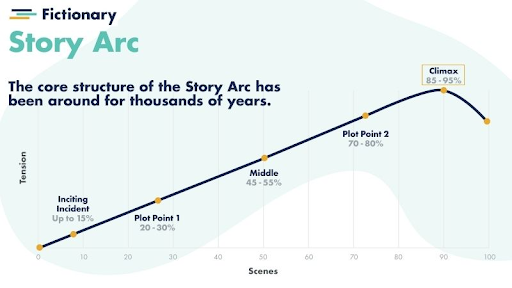Great stories don’t come together by accident. Powerful stories are crafted from our creative choices as writers and how we command all the story elements.
Stories are giant puzzles, and it’s our job as writers to put all the pieces together. Every story needs plot, character, and setting. Stories that resonate with readers are created with careful consideration of each of these important elements.
What is a Story Element?
Each story element is one piece of the story puzzle. Utilizing the story elements, writers make decisions about who their characters are, the problems they face, the change and growth they experience, and the deep meaning and point of their story. You need all the elements to create powerful stories that stay with your reader. Mastering the plot, character, and setting elements, also known as the Fictionary Supergroups, will ensure your readers can’t tear their eyes away from your pages.
We’re going to break down the supergroups into nine story elements you can use to create compelling characters, exciting and meaningful story events, and worlds that feel real.
Supergroups
Plot
The plot is simply what happens in your story, the events that unfold and the actions that drive your narrative. The events of the plot need to be closely linked, and it must be clear how one event leads to the next. A plot gives a story its structure, introducing themes and conflicts that nod to the deeper meaning of your story. Plot elements relate to what happens in your story and how it moves forward.
Character
Your characters are the people, animals, or beings that navigate your plot. The most important character of all is your protagonist. Characters give your reader someone to root for, worry for, and they provide the lens through which the reader will experience the story. Character elements include character goals, point of view, and the stakes. These elements are essential for creating complex, well-rounded, and dynamic characters.
Setting
Setting elements relate to where your story takes place. Setting is vital to building a world that comes alive through your pages, and immerses your reader into the atmosphere and tone of your story.
Plot
It goes without saying that without a plot there’s no story. But you don’t just need a plot, you need an engaging story that grips your readers from page one. A strong plot has a solid cause and effect trajectory, with interconnected scenes that drive the story forward.
Story Arc
The story arc consists of the five story critical plot points. These five essential scenes are the turning points in your story. Fictionary’s Story Arc is an incredible tool for making sure your story has each of these scenes and that they occur at the right time in your story.
It’s important to note that the ranges in the story arc are suggestions, and the placement of these scenes will depend on your unique plot. The story arc works as a guide to help you control the pacing and placement of your scenes.
Let’s break down each of these plot points and why they’re so crucial.
Inciting Incident
The inciting incident is the catalyst in every story, a dramatic change to your character’s ordinary world that thrusts them in a new direction. This scene can occur anytime within the first 15% of your story. What’s important is that you build up to this scene, first revealing your character’s ordinary world and hinting at why your character needs change.
Plot Point 1
At plot point 1, your protagonist decides to accept the story goal. This scene is considered the point of no return. They’ve made the decision to engage in the plot, and there’s no turning back. This turning point scene happens sometime between 20-30% in your novel.
Middle Plot Point
Your protagonist decides they want the story goal for themselves, and they begin actively chasing their goal. From this point on, the protagonist drives the plot with their decisions and choices. The middle plot point occurs somewhere between 45-55%.
Plot Point 2
This is the lowest moment in the story for your protagonist. Their decisions and choices since the middle plot point have caused disaster, and they believe they won’t be able to achieve their story goal. This low moment forces your protagonist to reflect on their mistakes, and they learn the final piece of information they need to pick themselves up and make one final stand at achieving their story goal. Plot point 2 occurs between 70-80% of the novel.
Climax
The climax of the scene is where the plot culminates. The story goal your protagonist has been chasing is finally addressed, and they either win or lose. This is the most intense scene in the entire novel and happens between 85-90% of the story.
Tension and Conflict
Tension and conflict are fundamental to telling interesting, engaging stories.
Tension is the anticipation of something big happening in the story. Negative tension makes the reader worry something bad is going to happen. On the other hand, the reader feels good tension when they expect something exciting is coming. Both types of tension are powerful and keep the reader wondering what will happen next.
Tension can be loud and in your face. Imagine a killer is on the loose, and your protagonist is out late at night on their own. Tension can also be softer and more subtle like an important secret a character struggles to keep.
Conflict, on the other hand, is the fight in action. Conflict occurs when that bad thing the reader has been worrying about plays out on the page.
Every scene needs either tension or conflict. While not every scene can be rife with conflict, I recommend including tension in every scene of your story. Whether the story is a horror, and the reader is dreading another murder, or it’s a romance, and they are excited for a quintessential meet-cute, the energy tension ignites keeps the reader turning the pages.
Entry and Exit Hooks
Hooks lure your reader in, creating intriguing questions, making them want to know more.
Have you ever sat down with a book intending to read just one chapter, only to find yourself an hour later ten chapters deep? Odds are that book was full of phenomenal hooks.
Entry and exit hooks work like reader glue, keeping them turning the pages to find out how things will turn out. Capturing your reader’s interest at the beginning and ending of every scene is key to holding their attention.
Hooks can be created through questions, foreshadowing, cliffhangers, plot twists, revelations, setbacks, and starting right in the action (media res). Variety is important with hooks to prevent your scenes from feeling predictable and keeping your readers wondering.
Review the opening and closing of every scene to make sure you’re using hooks to pull your reader through. Keep in mind that it’s important not to leave hooks hanging for too long. Some hooks can carry the reader through a few scenes, but it’s vital that you don’t leave too many unanswered questions, or you run the risk of frustrating your reader.
It’s a careful balance for sure, and I recommend answering some of the questions introduced through your hook while producing new questions for the reader to explore.
Character
Crafting compelling characters is no simple feat. Characters that resonate with readers are complex and dynamic. When characters strive for something important, readers will root for them. The key is connecting the reader with your characters, so they become invested in your character’s pursuit towards their goals. Let’s look at three essential elements involved in creating believable characters.
POV Character
This element will help you carefully consider and choose which character should have the point of view (POV) for each scene. If the reader gets multiple perspectives in one scene and is privy to every character’s thoughts, this is known as head hopping. Head hopping tends to pull the reader out of the story. This is why it’s so important to choose one point of view and stay true to that character’s perspective.
The POV character is the person we experience the scene through. It’s important for the reader to understand who the POV character is early in the scene, otherwise, they won’t know who they are rooting for, or why they should care.
Some writers choose to write from a single point of view, others choose multiple points of view. The choice is yours, and it depends on the type of story you’re writing and the experience you want to give the reader.
Single point of view allows the reader a closer connection to the protagonist, as they experience everything through their eyes. Multiple points of view allow for knowledge gaps, where the reader knows more than the protagonist. This is a structural strategy that can lead to more tension in the story as the reader anticipates the protagonist finding out what they know.
When using this element, ask yourself what character has the most at stake in the scene. Who offers the most invaluable insight as the scene unfolds? The character you choose might have the most impact emotionally, offer a shift in perspective, introduce a new obstacle, or be forced to make a decision that could ultimately change their direction.
Use this story element to keep track of your POV choice for each scene and to ensure your reader always knows whose perspective they’re in.
POV Goal
A POV goal is what your POV character wants in that scene. What are they striving for, or trying to avoid? This element is essential in order for your reader to understand why they should care. POV goals can be super simple or huge and complex. What matters most is that the POV Goal is important to your POV character and closely related to the overall story. It helps to put yourself in your reader’s shoes. Would you want to read the scene? The answer boils down to the POV goal.
Knowing your goal and stating it before you write the scene sets you up to convey your character’s wants and desires clearly to the reader.
What if Goal Fails?
This story element is focused on the stakes of the scene and relates to your character’s POV goal. What are the consequences if your character fails their scene goal? The stakes need to be strong and significant to the character, otherwise the reader won’t care if they succeed or fail. And if the reader doesn’t care, they’ll put the book down.
Stakes are the key to creating strong tension. Tension, the anticipation of something big happening, is what draws a reader through a story, cementing them to the pages.
Use What if Goal Fails to establish what your character will lose or sacrifice if they fail their POV goal. If there are no consequences, you know your character’s POV goal isn’t strong enough. This element helps you ensure all your POV goals matter and that your reader feels the weight and understands the consequences of your character’s potential failure.
Creating a Scene Promise
Are you ready for the magic? Combining POV Character, POV Goal, and What if Goal Fails creates what’s known as a Fictionary skeleton blurb. A skeleton blurb lays out who your POV character is, what they want, and the consequences should they fail for every single scene in your story. Also known as a scene promise, the skeleton blurb ensures each scene you write is important to the story as a whole and forms the framework for great scenes.
Using the following formula, construct a skeleton blurb for every scene in your story:
Shaping the elements into this format will lead to focused, powerful scenes!
Setting
Setting is one of the most overlooked of the supergroup elements, but it is just as important as character and plot. Setting encompasses everything to do with world-building including location, timeline, and mood.
Setting accentuates character emotions and intensifies the impact of your plot, creating more immersive and believable stories. Essentially, setting makes your story come alive.
Five Senses
Humans use sight, smell, sound, taste, and touch to collect information and make meaning about the world around us. Incorporating the five senses into your writing allows your reader to experience the story alongside your characters, engrossing them with your writing. Use of sensory details is one of the best strategies for avoiding the famous advice “Show, don’t tell”. The five senses can be used to set the mood of your scenes, immersing your reader in, revealing emotions, tension, and action without telling the reader what to feel.
When using senses in your writing, a good rule of thumb is to make sure each scene has three senses. I like to think of the senses as the spice in a meal. Add too much and it’s overwhelming, add too little, and the meal is boringly bland. Finding a good balance is key to creating vibrant scenes.
Emotional Impact
Not only do vivid locations absorb readers further into the story, but the locations we choose have the power to intensify the emotions of each scene. Using this element, you can decide the location of every scene based on how you want your reader and characters to feel. Locations can symbolize meaning for your character, both negative and positive.
Locations can stir up feelings such as:
- Safety
- Love
- Acceptance
- Success
- Unease
- Danger
- Vulnerability
- Failure
Choosing locations with lasting implications and emotional resonance for your characters will strengthen the impact of each scene for both the character and the reader.
For each scene, look at the POV goal and the main events that unfold. Use this element to determine if you’ve chosen locations that emphasize the intended emotional impact the scene has on your character.
Weather
Weather can be utilized to set the tone of the story, symbolize a story’s true meaning and themes, and create and intensify tension and conflict.
When used effectively, weather can even change the course of the plot, forcing characters to choose a new direction, creating obstacles to overcome, or bringing characters together.
Weather can also enhance character emotions. We can use it to heighten the conflict, reveal a character’s determination, or mirror a character’s internal arc of change.
While we don’t want to overwhelm the reader with weather in every scene, weather is a tool we can sprinkle throughout our stories to add meaning and depth.
Conclusion:
Character, plot, and setting form the basic structure of every novel. These elements work closely together and are essential for creating strong scenes and powerful stories.
We’ve looked at nine story elements you can use to craft stories with emotional depth, exciting plots, and immersive settings.
But, we’ve just scratched the surface! For those of you dying to know about all the story elements, I recommend you check out the 38 Fictionary Story Elements. The Fictionary 38 Story Elements encompass all the elements every writer needs to craft a novel readers love.
______________
About the Author: Ali Bumbarger is a Fictionary Certified StoryCoach Editor and Author Accelerator book coach. Her favorite genres include fantasy and science fiction. She is passionate about helping writers build their stories to their fullest potential. She offers actionable advice to help you strengthen your unique voice and create a novel readers love. You can learn more about Ali and other StoryCoach Certified Editors at Fictionary at https://fictionary.co/editors







